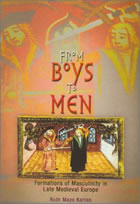Author's response
| Book: | From Boys to
Ruth Mazo Karras |
| Reviewer: | John H. ArnoldBirkbeck College, London |
I join John Arnold in hoping that other scholars will pursue the topic of medieval masculinities and fill some of the gaps left by the focus on three particular case studies in From Boys to Men. The most obvious gap, as he points out, is clerical masculinity among the clergy, both secular and regular, and in particular clerical discourses about masculinity. I would like to add some thoughts on possible directions that discussions of these issues might take.
The fundamental question when we discuss whether a given group in medieval European society lived up to ideals of masculinity (or femininity) is: whose ideals? To argue, as some scholars have done, that by rejecting sexual activity the clergy were abandoning masculinity for a third gender, raises the question of whether sexual activity was a central part of all medieval constructions of masculinity. The main features of the masculinities I discuss in From Boys to Men – independence and self-sufficiency, use of violence, domination of women, rationality – are all familiar to anyone with a passing acquaintance with popular culture in the twenty-first century. But we must consider the possibility that medieval society also had models or discourses of masculinity that are quite different from anything we might recognise today.
Potentially the most fruitful way to approach the question of whether medieval society constructed the clergy as masculine, feminine, or a third gender is to look carefully at language. Caroline Bynum most famously discussed the use by Cistercian writers of maternal imagery for the abbot, as well as for Jesus himself. But there are many other instances where monastic writings use masculine imagery, drawn from the secular realms of masculinity. The whole church hierarchy replicated the structure of a patriarchal family, and the struggle against temptation, or heresy, or Satan, could be expressed in militaristic terms. Of course, scholars face choices in how we understand these terms. When women as well as men struggle 'viriliter' against evil, what are the implications of translating this as 'manfully' rather than 'vigorously'? How much are we justified in concluding from language like this about medieval understandings of gender? Are formulaic expressions still meaningful, and how literally can they be (and were they) taken?
A great deal of scholarly discussion recently has focused on medieval homoeroticism. We have, I believe, moved beyond the point of denying any erotic ramifications to language drawn from the Song of Songs, or visions of oral and other physical contact with Christ. But it is still worth considering how such erotics are gendered. When Bernard of Clairvaux, in his sermons on the Song of Songs, discusses the pleasure of receiving Christ's spiritual kisses, does this receptivity place the reader in a feminine position? When Rupert of Deutz kisses Christ's open mouth and Christ receives the kisses, is Rupert playing an explicitly masculine role? What if a woman had described her vision in similar language? And what about another sort of homoeroticism, the friendships formed by monks like Aelred of Rievaulx? Was this just a 'situational homosociality' that developed in the absence of women, or should it be seen in the context of homosocial patterns in other areas of medieval life?
A discussion of clerical discourses around masculinity also raises the question, debated in the Middle Ages as much as today, of the relation between body and soul. Gender studies draws a distinction between having a male body and being masculine, having a female body and being feminine. Contemporary popular culture does not always draw that line so clearly. Nor did medieval culture. Medieval writers often explained aberrant gender behavior by reference to bodily characteristics. Were the clergy, then, different in body from other men? Indeed, perhaps so. Some celibates had to struggle mightily against the temptation to sexual activity, and the mere fact that they were tempted indicated their participation in this aspect of masculinity. Others were so pure as not to be tempted. But although this might be seen by hagiographers as a sign of holiness, a special gift from God, medical writers found bodily causes for the lack of sexual desire.
The gender of God is also at issue in a study of clerical discourse on masculinity. Jesus, like the Cistercian abbots, could be described as a mother; but God the Father is ... a father. Or is he? Studies of medieval theology have not always been informed by gender theory as much as they might, and questions about just what it means for man and woman to have been created in God's image are worth continued investigation. The discussion of Jesus's masculinity – not quite the same question as his sexuality, of which Leo Steinberg and Bynum have treated – is another area ripe for research. In what ways did it matter that the Word was made male rather than female flesh? The Roman Catholic church today takes the masculinity of Jesus as a justification for the exclusion of women from the priesthood. Such a justification may not have been needed in the Middle Ages when there was no strong challenge to the male priesthood, but Jesus's masculinity served all the same to provide a model for the clergy. Yet the imitation of Christ could be a goal for everyone, men and women, although the contexts in which this goal was most prominent were lay movements.
Many scholars, including Arnold himself, have begun to discuss these and other questions about clerical and other masculinities in medieval Europe. I hope that From Boys to Men provides a useful point of departure.
October 2003

